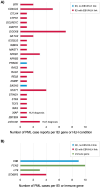Genetics of progressive multifocal leukoencephalopathy: update on case reports with an inborn error of immunity and risk variants found in drug-linked cases
- PMID: 40761639
- PMCID: PMC12320240
- DOI: 10.3389/fneur.2025.1629581
Genetics of progressive multifocal leukoencephalopathy: update on case reports with an inborn error of immunity and risk variants found in drug-linked cases
Abstract
A genetic predisposition to PML is now substantially supported by case reports of patients molecularly diagnosed with an inborn error of immunity (IEI) and progressive multifocal leukoencephalopathy (PML). Over the past 10 years, 4 IEI genes linked to PML has now grown to 26 as of 2025. Of these 26 genes believed to be causal of an IEI and PML, 24 (92%) are also linked with hemophagocytic lymphohistiocytosis/macrophage activation syndrome (HLH/MAS)-a severe hyper-inflammation syndrome associated with several IEI genes, most notably in 4 genes (PRF1, STX11, STXBP2, UNC13D) causing familial forms of the syndrome. Many HLH-linked genes are associated with life-threatening Epstein-Barr virus infections, which analogously suggests JC virus infection plus presence of a pathogenic variant in an HLH-linked IEI gene also increases risk of PML. PML also occurs as a serious adverse event for a subset of immunosuppressive therapies (e.g., natalizumab and rituximab) used to treat patients with immune disorders (e.g., multiple sclerosis and hematological malignancies). Recently, 4 PML risk variants were reported for use in a PML risk test to screen patients who are considering treatment with PML-linked therapies. Interestingly, of the 4 genes with a PML risk variant, 2 (LY9 and STXBP2) cause or are linked to HLH. The aim of our review is two-fold: (1) raise awareness among researchers and clinicians (e.g., neurologists, oncologists, and rheumatologists) that patient genetics are a key risk factor for PML, and (2) further reinforce the rationale for screening at-risk patients for PML risk variants before prescribing a PML-linked drug.
Keywords: JC virus; PML; hemophagocytic lymphohistiocytosis; immunodeficiency; inborn error of immunity; natalizumab; progressive multifocal leukoencephalopathy; rituximab.
Copyright © 2025 Eis, Smith, Jalilzadeh and Hatchwell.
Conflict of interest statement
EH (UK), ES (USA), PE (USA) and SJ (UK) are employees of Population Bio, Inc.
Figures


Similar articles
-
Natalizumab for relapsing remitting multiple sclerosis.Cochrane Database Syst Rev. 2011 Oct 5;(10):CD007621. doi: 10.1002/14651858.CD007621.pub2. Cochrane Database Syst Rev. 2011. PMID: 21975773
-
Natalizumab for induction of remission in Crohn's disease.Cochrane Database Syst Rev. 2006 Jul 19;(3):CD006097. doi: 10.1002/14651858.CD006097. Cochrane Database Syst Rev. 2006. Update in: Cochrane Database Syst Rev. 2007 Jan 24;(1):CD006097. doi: 10.1002/14651858.CD006097.pub2. PMID: 16856112 Updated.
-
Fatal HLH in patients with X-linked lymphoproliferative disease 1 due to a novel variant in SH2D1A: case report.Front Immunol. 2025 May 19;16:1602107. doi: 10.3389/fimmu.2025.1602107. eCollection 2025. Front Immunol. 2025. PMID: 40458416 Free PMC article.
-
Natalizumab for induction of remission in Crohn's disease.Cochrane Database Syst Rev. 2007 Jan 24;(1):CD006097. doi: 10.1002/14651858.CD006097.pub2. Cochrane Database Syst Rev. 2007. Update in: Cochrane Database Syst Rev. 2018 Aug 01;8:CD006097. doi: 10.1002/14651858.CD006097.pub3. PMID: 17253580 Updated.
-
Hemophagocytic Lymphohistiocytosis Gene Variants in Severe Aplastic Anemia and Their Impact on Hematopoietic Cell Transplantation Outcomes.Transplant Cell Ther. 2024 Aug;30(8):770.e1-770.e10. doi: 10.1016/j.jtct.2024.05.017. Epub 2024 May 27. Transplant Cell Ther. 2024. PMID: 38810947 Free PMC article.
References
Publication types
LinkOut - more resources
Full Text Sources
Miscellaneous

